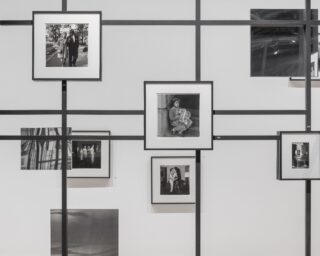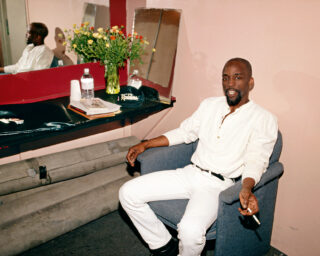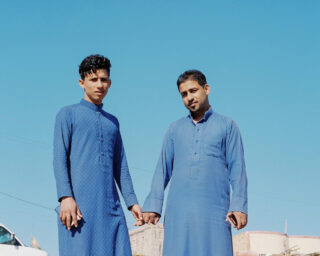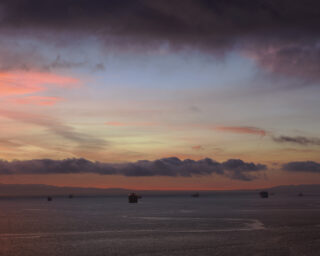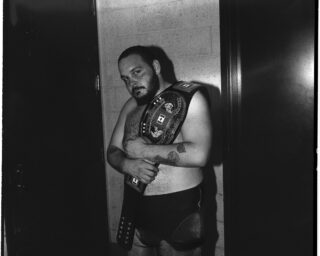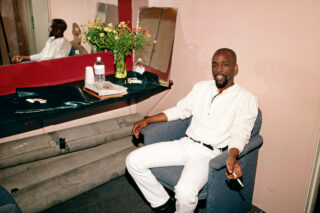Willie Doherty – Without Trace – Zurich
The ten photographs in the first room of Willie Doherty’s exhibition Without Trace seem both strangely immediate and familiar. They are all views of Zurich’s snow-covered outskirts in winter, the season that has just passed. They were taken on several visits to Zurich that Doherty undertook in recent months, an unusual move for an artist whose work has mostly focused on his native Northern Ireland. And although locals will easily recognize some locations, in particular those taken near the two rivers that run through the city, the large-format prints also look like they could have been taken anywhere in continental Europe. The peripheral places they show seem generic and anonymous—the snow-covered bank of river, concrete modernist buildings, a highway overpass in the woods, a panoramic view of the city on a grey day, dish antennas next to some modular temporary housing. The sky, save for one image, is gray, the light even and fallow. The snow eliminates details and colors, making the sites even more indeterminate. The strict composition of the photographs, often emphasizing a central perspective, underlines their severity. This seems to be a documentary series about the margins of the city where the built environment and nature intersect, often in a jarring contrast.
The wall-size video projection in the second room cunningly transforms this first impression. The video includes views similar to those in the photographs, yet the temporality of the moving images makes the sites appear more still, more forlorn. A female voice with strong foreign accent, seemingly Eastern European, tells the story of a man who had decided to spend a winter in Zurich. It’s not the photographer, as the viewer might have surmised, but instead a construction worker who has disappeared without any trace on the morning of December 12. A number of notebooks found in his apartment indicate that he felt increasingly isolated in the city. The narrator intones, “He had given up his construction job and spent his days wandering,” and he seems to have spent most of his time in places like those shown in the photographs and the video. An increasing sense of paranoia and dread had gripped him. He had sensed that the city harbored dreadful secrets, and only the rivers and the snow offered him solace. One day, he simply disappeared. The video ends with views of a frozen lake in the woods, while the woman relates that she dreamt “last night” that his corpse was lying in a frozen lake, waiting to be uncovered by the spring sun.

Willie Doherty, Without Traces, 2013. Installation view at Peter Kilchmann, Zurich. Courtesy of the artist and Peter Kilchmann, Zurich.
Doherty used a similar combination of landscape views and a voice-over narration in his video Secretion (2012), presented last summer at Documenta 13. It showed decrepit industrial landscapes near Kassel, while the voice-over told the similarly Poe-like story of a former concentration-camp warden who is killed, some years after World War II, by the seepage of human remains into the drinking water, destroying his body in the form of fungal spores. Both works examine the traces of the past harbored by industrial landscapes, and the alienation they induce. The photographs in Without Traces add yet another layer of complexity to Doherty’s dense docu-fictions. At the outset, they appear to be rather straight-on documentary images. Seeing them a second time, after encountering the video projection, they are imbued with the construction worker’s narrative. They appear to show Doherty’s retracing of the construction worker’s fatal stay in Zurich. Indeed, these might be the photographs the anonymous worker would have taken himself. Doherty’s adroit manipulation of our perception points to the inherent malleability of photographic images whose content is easily twisted by additional information. A paranoia similar to the one experienced by the story’s construction worker begins to haunt the viewer, who acutely experiences how easily she may be manipulated. The images are indeed not what they seem—just like the city that refuses to yield its dreadful secrets.
Martin Jaeggi is an independent writer and curator. He writes frequently about photography and contemporary art and teaches in the photography department of the Zurich University of the Arts.
Willie Doherty’s exhibition remains on view at Peter Kilchmann, Zurich, until April 13.












